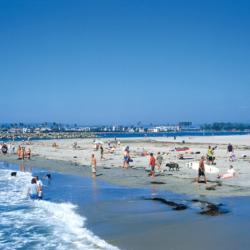Source Institutions
Source Institutions
Add to list Go to activity
Activity link broken? See if it's at the internet archive

Why is ocean water sometimes the warmest when the average daily air temperature starts to drop? In this activity, learners explore the differing heat capacities of water and air using real data. They analyze graphs of air and water temperature, create their own graphs of temperature range, describe the difference in the heat capacities of air and water, and explain the practical applications of water’s high heat capacity. Includes background information and suggestions for going further.
- Under 5 minutes
- 45 to 60 minutes
- 1 cent - $1 per student
- Ages 11 - 18
- Activity, Lesson/Lesson Plan
- English
Quick Guide
Subjects
-
Earth and Space Science
-
Earth Processes
- Geochemical Cycles
- Weather and Climate
-
Earth Structure
- Oceans and Water
-
Earth Processes
-
Engineering and Technology
-
Engineering
- Fire Protection Engineering
- Metallurgy and Materials Engineering
- Ocean Engineering
- Technology
-
Engineering
-
Mathematics
-
Algebra
- Equations and Inequalities
-
Data Analysis and Probability
- Data Analysis
- Data Collection
- Data Representation
- Number and Operations
-
Algebra
-
Physical Sciences
-
Heat and Thermodynamics
- Heat and Temperature
- Heat Transfer
- Thermodynamics and Entropy
-
States of Matter
- Liquids
- Gases
- Changes of Phase
-
Heat and Thermodynamics
-
The Nature of Science
-
The Scientific Process
- Gathering Data
- Formulating Explanations
- Communicating Results
-
The Scientific Process
-
The Nature of Technology
-
Technology and Society
- Impacts of Technology
- Technology and the Environment
-
Technology and Society
Informal Categories
- Nature and Environment
Audience
To use this activity, learners need to:
- see
- see color
- read
- use keyboard
- use mouse
- touch
Learning styles supported:
- Uses STEM to solve real-world problems
- Involves hands-on or lab activities
Other
Components that are part of this resource:
- Student Worksheet (downloadable pdf)
- Figures 1-3 (downloadble pdf)
- Completed graph (downloadable pdf)
Includes alignment to state and/or national standards:
This resource is part of:
Access Rights:
- Free access
By:
- Petrone, Christopher J.
Rights:
Funding Sources:
- NOAA Sea Grant
- National Marine Educators Association
